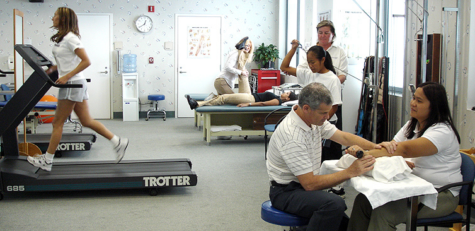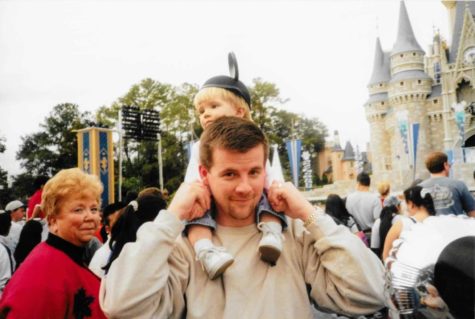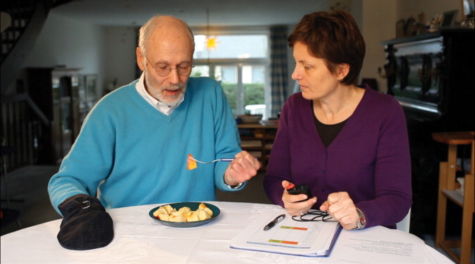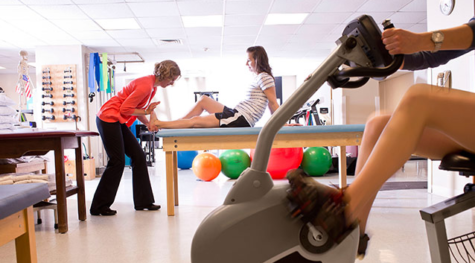Differentiation of Physical Therapists in the Field
In the United States, approximately 185,500 people are employed as physical therapists, and the demand continues to grow (“How Many People”). Physical therapy is a necessity for many people, whether it be because of an injury, a disease, or simply just old age. Thankfully, physical therapy options are offered at numerous places throughout the country, and with a doctor’s suggestion it is easier than ever to receive care. Conveniently doctors are able to steer their patients in the right direction, thanks to the differentiation of physical therapists’ services. Within the physical therapy field, five main practices target specific issues. Even though many believe physical therapy is one broad subject, many different types work directly with the patient for best results and are designed to help unique audiences.
Though unfortunate, the need for physical therapy does not wait for anyone. Practices are dedicated to specific groups of people, such as pediatric physical therapists who specialize in the treatment of children and young adults (“Pediatric Physical Therapist”). While children receive the care of physical therapists, they are most often treated for reasons other than injury. Many are treated for childhood diseases or birth defects such as: cerebral palsy, traumatic brain injuries, chronic pain, cystic fibrosis, cancer, scoliosis, developmental delays, and movement disorders in result of premature birth (“How To Become”). Quite a bit differs between treating a child and an adult when it comes to physical therapy, mainly because of the strain physical therapy can have on the mind and body of its patients. To make therapy easier for children, physical therapists use different kinds of equipment, incorporate technology, and games into the children’s routine therapy (“LokoHelp Engages Pediatric”). With the help of pediatric therapy, children can grow stronger and healthier than ever before.
On the other end of the spectrum, physical therapy is also needed for older patients; geriatric physical therapists specialize in treating the elderly. Geriatric physical therapists often work in nursing homes or outpatient facilities and help the elderly escalate their physical wellbeing as they age by narrowing in on ailments such as: arthritis,  osteoporosis, alzheimer’s disease, and joint soreness (“Geriatric Physical Therapist”). Similar to the other practices of physical therapy, geriatric physical therapy focuses on one main goal – making everyday tasks easier. Geriatric physical therapy is used in order to “restore mobility, increase fitness levels, and reduce pain” among other health benefits in older adults (“Geriatric Physical Therapy”). One of the main goals to achieve for patients is increased independence, so building up strength is a necessity. Though difficult at an older age, with the guidance of a physical therapist geriatric patients can regain their strength and independence.
osteoporosis, alzheimer’s disease, and joint soreness (“Geriatric Physical Therapist”). Similar to the other practices of physical therapy, geriatric physical therapy focuses on one main goal – making everyday tasks easier. Geriatric physical therapy is used in order to “restore mobility, increase fitness levels, and reduce pain” among other health benefits in older adults (“Geriatric Physical Therapy”). One of the main goals to achieve for patients is increased independence, so building up strength is a necessity. Though difficult at an older age, with the guidance of a physical therapist geriatric patients can regain their strength and independence.
This next practice is unique; according to Life Fitness Physical Therapy, Cardiopulmonary Physical Therapy is physical therapy focused on the function of the cardiopulmonary to prevent disease and help those suffering to function better (“The Health Benefits”). When people hear the term cardiopulmonary, they may be a bit confused, but it is simple — cardiopulmonary indicates something relating to the heart and lungs. As one can imagine cardiopulmonary issues can get pretty serious; this is where cardiopulmonary therapists offer their services, their main goal being to push patients to regain function in the cardiac and respiratory system following an injury or illness (“Cardiopulmonary Therapist”). Cardiopulmonary physical therapy, though rare by name, is not uncommon. Some of the most common issues result in the need of this type of therapy, these incidents may be: heart valve replacement, post coronary bypass surgery, and coronary stent placement (“The Health Benefits Of”). Physical therapists work closely and personally with these patients to ensure the best possible outcome. Injuries of the cardiopulmonary type can be debilitating, and regaining normal life can be difficult; however with the help of therapy, one can become his/her best self sooner rather than later.
Moving to a different vital part of the body, according to the Academy of Neurological Physical Therapy, neurological physical therapist specialize in the evaluation and treatment of individuals with movement problems due to disease or injury of the nervous system (“What Is a Neurological”). Neurological physical therapy is extremely important to the patients as it will help them return to their highest possible level of function and independence. Those that receive this type of therapy may be suffering from: stroke, spinal cord injury, brain injury, parkinson’s disease, multiple sclerosis, and guillain-barre syndrome (“Neurological Physical Therapy”). Without receiving the right type of therapy, patients suffering from neurological diseases or injuries may never regain function, be able to perform everyday tasks, and they may lose their independence for good. The rehabilitation programs these patients are put into are designed to meet the individual’s needs, and is dependent on the specific problem or disease as well as the active involvement of the patient (“What Is Neurological Rehabilitation”). By following the right type of treatment and actively participating in the rehabilitation, neurological therapy patients are given their best shot to improve mobility.
Finally, perhaps the most common practice within the physical therapy field is orthopedic therapy; orthopedic physical therapists are specially trained in recognizing diagnosis, management, and prevention of musculoskeletal disorders (“Practice Areas”). Orthopedic therapy is important for a variety of people from athletes to the average joe. This type of therapy is wildly popular because it helps reduce pain, increase strength, help soothe swelling, and many other popular symptoms of an injury. This specific form of treatment, according to orthopedic specialists, focuses on the treatment or rehabilitation of injuries to the orthopedic system, which includes: muscles, bones, joints, tendons, and ligaments (“Orthopedic Physical Therapy Specialists”). Because of the high demand this therapy receives, orthopedic physical therapists offer their services in a variety of ways, including outpatient services, within hospitals, sports clinics, and if need be, home visits. With the gracious help of these experts and their assessment of movement, their patients can improve their movement with minimal pain through skilled manual therapy, therapeutic exercise and patient education (“Practice Areas”). For many, orthopedic therapy can be a life saver, helping them return to their active lifestyles in no time.
This type of therapy is wildly popular because it helps reduce pain, increase strength, help soothe swelling, and many other popular symptoms of an injury. This specific form of treatment, according to orthopedic specialists, focuses on the treatment or rehabilitation of injuries to the orthopedic system, which includes: muscles, bones, joints, tendons, and ligaments (“Orthopedic Physical Therapy Specialists”). Because of the high demand this therapy receives, orthopedic physical therapists offer their services in a variety of ways, including outpatient services, within hospitals, sports clinics, and if need be, home visits. With the gracious help of these experts and their assessment of movement, their patients can improve their movement with minimal pain through skilled manual therapy, therapeutic exercise and patient education (“Practice Areas”). For many, orthopedic therapy can be a life saver, helping them return to their active lifestyles in no time.
Ultimately, many people may be oblivious to how the physical therapy field works, but with the right education these practices could change the lives of many. Within the field, five different practices of physical therapy, pediatric, geriatric, cardiopulmonary, neurological, and orthopedic, are targeted to treat specific audiences and help patients get back on their feet in the least amount of time possible. For each therapy practice it is true that active patient participation is key to success, with the interactive help of physical therapists of course, the patient will come back stronger and better than ever.
Works Cited
“Cardiopulmonary Therapist: Job Description & Career Requirements.” Study.com, study.com/articles/Cardiopulmonary_Therapist_Job_Description_and_Requirements_for_a_Career_as_a_Cardiopulmonary_Therapist.html. Accessed 25 Apr. 2017.
“Geriatric Physical Therapist: Job Description & Career Requirements.” Study.com, study.com/articles/Geriatric_Physical_Therapist_Job_Description_and_Requirements_for_a_Career_in_the_Geriatric_Physical_Therapies.html. Accessed 25 Apr. 2017.
“Geriatric Physical Therapy: Facts & Information.” Disabled World, 18 Nov. 2015, www.disabled-world.com/medical/rehabilitation/therapy/geriatric-therapy.php. Accessed 25 Apr. 2017.
“The Health Benefits Of Cardiopulmonary Physical Therapy Archives.” Life Fitness Physical Therapy, www.lifefitnesspt.com/blog/tag/the-health-benefits-of-cardiopulmonary-physical-therapy/. Accessed 25 Apr. 2017.
“How Many People Are Currently Employed as a Physical Therapists in the United States?” StudentScholarships.org, www.studentscholarships.org/professions/359/employed/physical_therapists.php. Accessed 25 Apr. 2017.
“How to Become a Pediatric Physical Therapist.” InnerBody, www.innerbody.com/careers-in-health/how-to-become-a-childrens-physical-therapist.html. Accessed 25 Apr. 2017.
“LokoHelp Engages Pediatric Physical Therapy Patients One Step at a Time.” Woodway, 12 Aug. 2016, www.woodway.com/blog/medical-industry/lokohelp-engages-pediatric-physical-therapy-patients-one-step-time. Accessed 26 Apr. 2017.
“Neurological Physical Therapy.” Franciscan Health, www.franciscanhealth.org/health-care-services/neurological-physical-therapy-255. Accessed 25 Apr. 2017.
“Orthopedic Physical Therapy Specialists in MA, NH & CT.” ProExPT | Orthopedic Physical Therapy Specialists | NH MA CT, www.proexpt.com/OrthopedicPhysicalTherapy. Accessed 25 Apr. 2017.
“Pediatric Physical Therapist: Job Description and Requirements.” Study.com, study.com/articles/Pediatric_Physical_Therapist_Job_Description_and_Requirements.html. Accessed 25 Apr. 2017.
“Practice Areas.” American Physical Therapy Association, 22 Jan. 2016, www.moveforwardpt.com/forhealthcareprofessionals/detail/practice-areas. Accessed 25 Apr. 2017.
“What Is a Neurologic Physical Therapist.” What Is a Neurologic Physical Therapist, www.neuropt.org/consumer-info/what-is-a-neurologic-physical-therapist. Accessed 28 Apr. 2017.
“What Is Neurological Rehabilitation?” Johns Hopkins Medicine Health Library, www.hopkinsmedicine.org/healthlibrary/conditions/physical_medicine_and_rehabilitation/neurological_rehabilitation_85,P01163/. Accessed 25 Apr. 2017.










Lawrence Parks • Aug 16, 2017 at 11:43 PM
Hi there, yup this article is in fact pleasant and I have learned lot of things from it about blogging. Thanks for sharing and keep updating more!